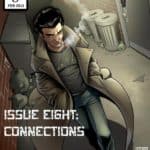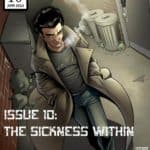Part Two: Elmuth Shipping
It’s early evening, but not yet dark, when he finally reaches the Elmuth Shipping compound. CB wonders if it’ll be as heavily guarded as TriHealth. It isn’t. It has security, but prowling around the fence he doesn’t see anything out of the ordinary: chain link fence, barbed wire on top, bored blue-shirts not paying a lot of attention to their jobs. The fence is in lousy condition, and there’s a section on one side that’s come loose from its moorings. It’s trivial to crawl through.
That’s the problem with conspiracies. You just can’t rely on your contractors to hold up their end of things.
There are plenty of trucks parked in the lot, but they all have Elmuth logos on them. He wants the unmarked trucks—eventually he finds them at the far end, parked next to a windowless building, smaller than the main office and very heavily locked. The windows are barred, a metal grate is pulled down over the door, and the grate is padlocked shut. It reminds CB of Elliot Grady’s pawn shop.
It’s the most aggravating place in the compound to get into, so he figures that’s where he needs to look first.
He mills around for a bit, testing the doors of each of the unmarked trucks parked near the building until he finds one unlocked. He opens the door and climbs into the cab, closing the door behind him, then manually turns off the overhead lights. He exits the cab and carefully makes his way to the main office. There are still lights on in that building, but the garage on the side is dark and silent. He tries the office entrance to the garage—locked, but it’s an average, commercial-grade doorknob lock. In a few minutes he jimmies the lock and slips into the office. They didn’t bother locking the door between the office and the bay.
A few minutes later he finds what he’s looking for: bolt cutters and a new padlock. He puts the bolt cutters under his trenchcoat, the padlock in his trenchcoat pocket, and makes his way back out to the smaller building. It’s dark now, so it’s easier to get around without being seen. At the smaller building he uses the bolt cutters to cut open the padlock: it’s every bit as loud as he was afraid it would be, and then some. He quickly retrieves the cut padlock, replaces it with the new padlock—he makes sure it isn’t completely closed, just enough to be overlooked in a casual inspection—then hurries to the truck with the unlocked doors and deactivated overhead lights. He slips into the cab, locks the doors, worms his way into the space behind the seats, and waits.
It doesn’t take long for a few security guards to show up. He hears one rattle the grate to make sure it’s closed, while others go from truck to truck, checking to make sure the doors are locked. CB finds an army blanket stowed under the driver’s seat and pulls it out, spreading it over himself as he forces himself to lie completely still. Then he waits and listens.
The guard checking out the grate over the door doesn’t go beyond the first rattle, so CB assumes the new padlock didn’t do anything inconvenient. He can hear the other guards trying the doors to the trucks around him. Eventually he hears the driver’s-side door shake, then the passenger’s-side, then sees the reflection of a flashlight through the folds of his blanket as the guard shines it through the window. Then he hears the squelch of a walkie-talkie.
“False alarm.” The voice is faint through the truck but sounds distinctly relieved. “I don’t know what it was, but everything looks fine over here. We’re headed back. There better be pizza left.”
CB waits five minutes after he stops hearing the guards before he peers out the window. He’s alone again. He grabs the bolt cutters, slips out the passenger-side door, and heads back over to the grate. The padlock has done something inconvenient—it’s hanging open. He’s grateful Ray and Curtis don’t work here—he’s pretty sure they’d notice something like that. He stuffs the padlock in his pocket, then pulls at the bottom of the gate. It creaks a bit, and he stops. He starts to inch the gate up, bit by bit, minimizing the sound the gate makes. He raises it enough so he can get at the door lock—a heavier lock than the door to the garage office, but he manages it. The door swings open inward, and CB stoops, steps under the grate, and eases it down behind him. He puts the padlock back on to complete the picture, then steps into the building, closing the door behind him.
It is pitch dark. He fishes out his Mag Lite.
He stands in a single large office complete with a small kitchenette, a beat-up microwave, and an old Mr. Coffee coffee maker. The pot still has coffee in it—about a quarter full—and three plastic bottles of powdered creamer, all open, sit next to it. One large metal desk sits in the center of the room. An old computer, an even older laser printer, and a combination scanner/fax machine all crowd the desktop. A row of old-school metal filing cabinets line one wall.
No windows in the room, but CB decides against turning on the lights: the door, while heavy, doesn’t quite seal the frame, and any light that spills through will invite investigation. Still, he sees no reason not to turn on the computer. The computer is old—it still uses a square, heavy CRT monitor, which displays the Windows 95 splash logo as old hard disks sluggishly grind into action. It’s going to take a while. Time to focus on other things.
The filing cabinets are unlocked and contain personnel files and badges. The badges look like the ones contractors used to get into the loading area of the TriHealth building. This is confirmed in the personnel files: each file lists what businesses the employee has access to, and a number of them list TriHealth. CB studies the badges curiously. Each has a microchip embedded into the card, just like the ones he saw earlier today.
The computer beeps, and CB turns his attention back to the desk, sitting in an old office chair that creaks under his weight. He finds the computer password written down on a piece of paper in the top desk drawer. A minute later the computer loads the desktop, and CB starts looking through its contents.
The computer has Microsoft Office loaded on it. CB opens Excel, then opens the most recently used document. As expected, it’s a spreadsheet of shipment schedules, listing both origin and destination points. He sorts the spreadsheet alphabetically by destination and searches for TriHealth, turning on the laser printer with his free hand.
“There.” CB sits back in smug satisfaction. He’s staring at a list of all the companies TriHealth accepted shipments from in the last six months. He selects those entries, and the laser printer hums to life, printing out only the selected rows. As it starts to spit out page after page of information, CB returns his attention to the filing cabinets and the personnel files.
The last cabinet on the right is locked.
CB frowns. The fact that the filing cabinet is locked probably means there’s something interesting in it, but these filing cabinets are serious business, and the locks are much smaller and more complicated than the one on the front door. He’s pretty sure he won’t be able to pick it, and wonders if he can use the bolt cutters to pry it open. On a hunch, he goes back to the desk and starts rummaging through the drawers. The top desk drawer has a set of keys. The smallest key fits perfectly, and the cabinet slides open.
There are only four folders in the top drawer. CB picks up the first folder, opens it, and whistles softly. Inside is another badge, similar in size to the badges in the other cabinets but black with a red TriHealth logo instead of the nondescript gray. These, CB decides, are VIP badges that give access to other parts of the building.
CB pockets one and closes the filing cabinet drawer. A moment later he sighs, reopens the filing cabinet drawer, takes another badge from a second folder then closes the drawer again.
Once the printer is finished, he folds up the printout and stuffs it into one of his pockets. Then he turns off the printer, shuts down the computer, and waits by the door, listening. Eventually he hears one of the guards wander by, his walkie-talkie emitting short bursts of white noise as he passes. Two minutes later, CB cautiously opens the door and peers out.
No one there. He locks the door, removes the padlock, slides up the fence just high enough to slip under, then shuts everything up tight behind him. Twenty minutes later he crawls out from under the loose portion of the chain link fence and makes his way back to the bunker.


